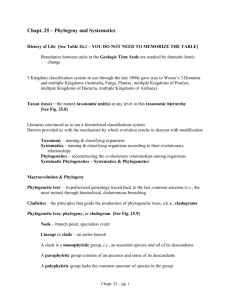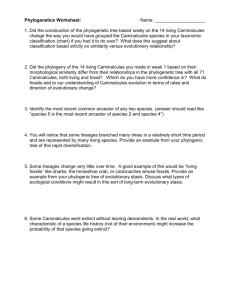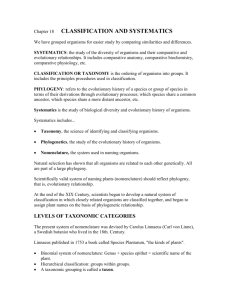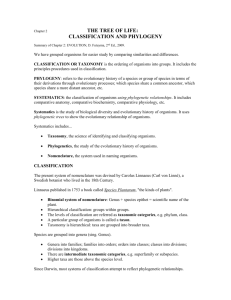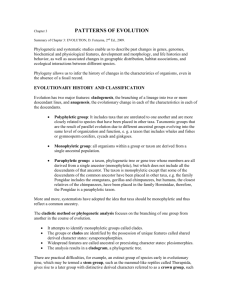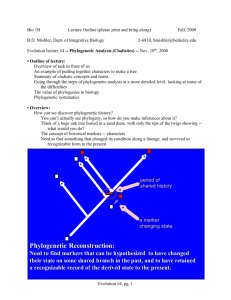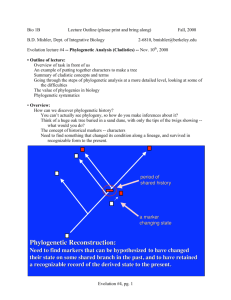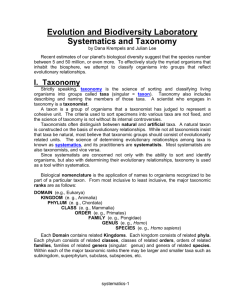AP Biology Vocabulary & Roots: Ch
advertisement
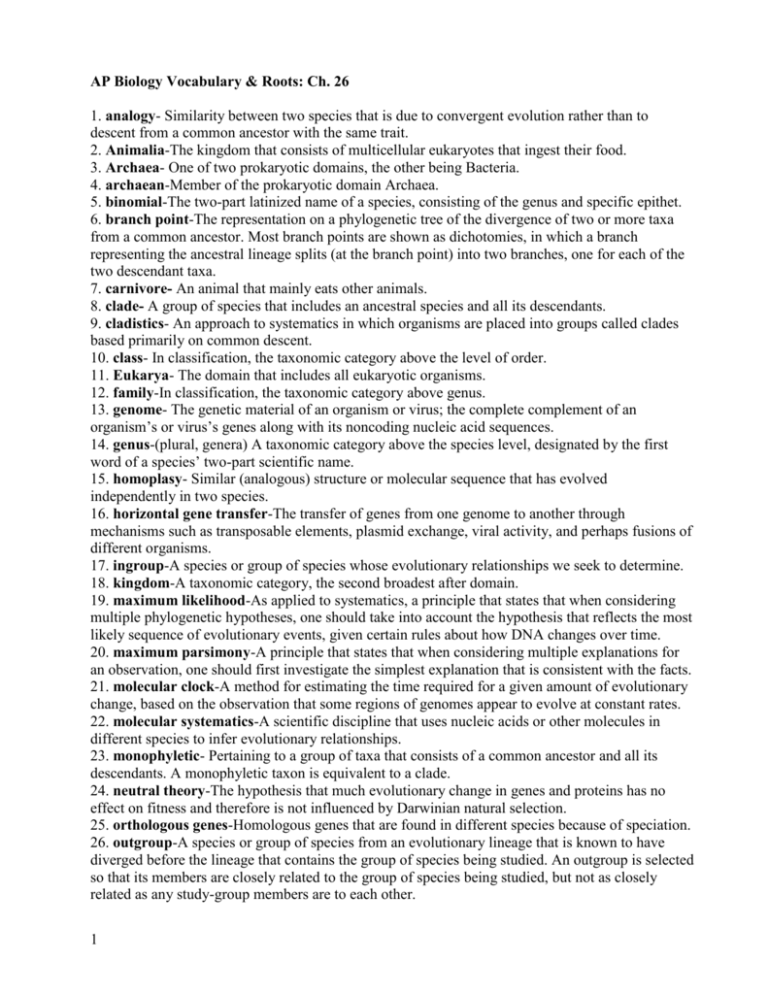
AP Biology Vocabulary & Roots: Ch. 26 1. analogy- Similarity between two species that is due to convergent evolution rather than to descent from a common ancestor with the same trait. 2. Animalia-The kingdom that consists of multicellular eukaryotes that ingest their food. 3. Archaea- One of two prokaryotic domains, the other being Bacteria. 4. archaean-Member of the prokaryotic domain Archaea. 5. binomial-The two-part latinized name of a species, consisting of the genus and specific epithet. 6. branch point-The representation on a phylogenetic tree of the divergence of two or more taxa from a common ancestor. Most branch points are shown as dichotomies, in which a branch representing the ancestral lineage splits (at the branch point) into two branches, one for each of the two descendant taxa. 7. carnivore- An animal that mainly eats other animals. 8. clade- A group of species that includes an ancestral species and all its descendants. 9. cladistics- An approach to systematics in which organisms are placed into groups called clades based primarily on common descent. 10. class- In classification, the taxonomic category above the level of order. 11. Eukarya- The domain that includes all eukaryotic organisms. 12. family-In classification, the taxonomic category above genus. 13. genome- The genetic material of an organism or virus; the complete complement of an organism’s or virus’s genes along with its noncoding nucleic acid sequences. 14. genus-(plural, genera) A taxonomic category above the species level, designated by the first word of a species’ two-part scientific name. 15. homoplasy- Similar (analogous) structure or molecular sequence that has evolved independently in two species. 16. horizontal gene transfer-The transfer of genes from one genome to another through mechanisms such as transposable elements, plasmid exchange, viral activity, and perhaps fusions of different organisms. 17. ingroup-A species or group of species whose evolutionary relationships we seek to determine. 18. kingdom-A taxonomic category, the second broadest after domain. 19. maximum likelihood-As applied to systematics, a principle that states that when considering multiple phylogenetic hypotheses, one should take into account the hypothesis that reflects the most likely sequence of evolutionary events, given certain rules about how DNA changes over time. 20. maximum parsimony-A principle that states that when considering multiple explanations for an observation, one should first investigate the simplest explanation that is consistent with the facts. 21. molecular clock-A method for estimating the time required for a given amount of evolutionary change, based on the observation that some regions of genomes appear to evolve at constant rates. 22. molecular systematics-A scientific discipline that uses nucleic acids or other molecules in different species to infer evolutionary relationships. 23. monophyletic- Pertaining to a group of taxa that consists of a common ancestor and all its descendants. A monophyletic taxon is equivalent to a clade. 24. neutral theory-The hypothesis that much evolutionary change in genes and proteins has no effect on fitness and therefore is not influenced by Darwinian natural selection. 25. orthologous genes-Homologous genes that are found in different species because of speciation. 26. outgroup-A species or group of species from an evolutionary lineage that is known to have diverged before the lineage that contains the group of species being studied. An outgroup is selected so that its members are closely related to the group of species being studied, but not as closely related as any study-group members are to each other. 1 27. paralogous genes-Homologous genes that are found in the same genome as a result of gene duplication. 28. paraphyletic- Pertaining to a group of taxa that consists of a common ancestor and some, but not all, of its descendants. 29. PhyloCode-System of classification of organisms based on evolutionary relationships: Only groups that include a common ancestor and all of its descendents are named. 30. phylogenetic bracketing-An approach in which features shared by two groups of organisms are predicted (by parsimony) to be present in their common ancestor and all of its descendants. 31. phylogenetic tree-A branching diagram that represents a hypothesis about the evolutionary history of a group of organisms. 32. phylogeny-The evolutionary history of a species or group of related species. 33. phylum-(plural, phyla) In classification, the taxonomic category above class. 34. Plantae-The kingdom that consists of multicellular eukaryotes that carry out photosynthesis. 35. polyphyletic-Pertaining to a group of taxa derived from two or more different ancestors. 36. polytomy- In a phylogenetic tree, a branch point from which more than two descendant taxa emerge. A polytomy indicates that the evolutionary relationships among the descendant taxa are not yet clear. 37. rooted-Describing a phylogenetic tree that contains a branch point (typically, the one farthest to the left) representing the last common ancestor of all taxa in the tree. 38. shared ancestral character-A character, shared by members of a particular clade, that originated in an ancestor that is not a member of that clade. 39. shared derived character-An evolutionary novelty that is unique to a particular clade. 40. sister taxa-Groups of organisms that share an immediate common ancestor and hence are each other’s closest relatives. 41. systematics-A scientific discipline focused on classifying organisms and determining their evolutionary relationships. 42. taxon- A named taxonomic unit at any given level of classification. 43. taxonomy- A scientific discipline concerned with naming and classifying the diverse forms of life. Word Roots analog- = proportion (analogy: similarity due to convergence) bi- = two; nom- = name (binomial: a two-part latinized name of a species) clado- = branch (cladogram: a dichotomous phylogenetic tree that branches repeatedly) homo- = like, resembling (homology: similarity in characteristics resulting from a shared ancestry) mono- = one (monophyletic: pertaining to a taxon derived from a single ancestral species that gave rise to no species in any other taxa) parsi- = few (principle of parsimony: the premise that a theory about nature should be the simplest explanation that is consistent with the facts) phylo- = tribe; -geny = origin (phylogeny: the evolutionary history of a taxon) 2



